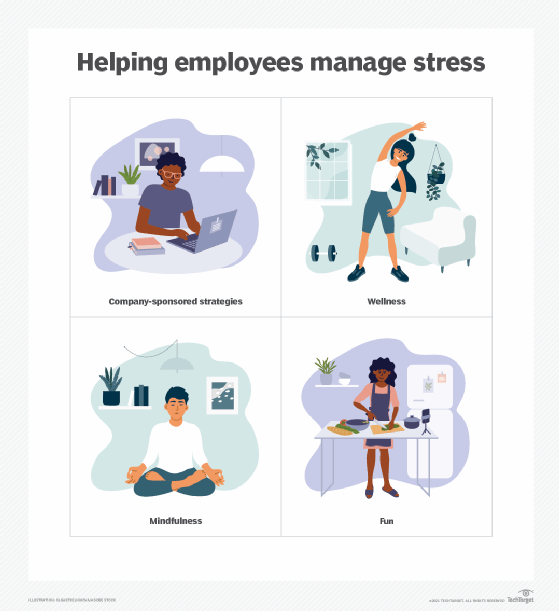
daniilvolkov - stock.adobe.com
Quiet quitting explained: Everything you need to know
While not a new concept, the term 'quiet quitting' has recently gained popularity on social media as some employees reject the hustle culture and set job boundaries.
Quiet quitting is the latest workplace buzzword. Although it sounds like it refers to someone resigning from their position, it describes a rebellion against the hustle culture of going above and beyond what a job requires.
The COVID-19 pandemic not only disrupted everyone's lives with restrictions and a lockdown on public gatherings; it also made some people rethink their career choices. During what's known as the Great Resignation, 71.6 million people left their jobs from April 2021 through April 2022, which averages 3.98 million people quitting monthly, according to the U.S. Bureau of Labor Statistics. In June 2022, the number of people quitting reached 4.2 million.
Not only are people resigning from positions, they also want to limit their workloads. Enter quiet quitting -- the new way of doing a job's bare minimum.
What is quiet quitting?
Quiet quitting doesn't mean an employee has left their job, but rather has limited their tasks to those strictly within their job description to avoid working longer hours. They want to do the bare minimum to get the job done and set clear boundaries to improve work-life balance. These employees are still fulfilling their job duties but not subscribing to 'work is life' culture to guide their career and stand out to their superiors. They stick to what is in their job description and when they go home, they leave work behind them and focus on non-work duties and activities.
However, quiet quitting could be a sign that an employee is not happy in their position or is experiencing burnout. Quiet quitting is a way the employee deals with burnout to help alleviate stress. It may also mean they are ready to change positions or may be currently looking for another job.
During the Great Resignation, employees started thinking about their careers, salaries and how they are treated at work. Lack of advancement opportunities, low pay and feeling disrespected were the top reasons Americans quit their jobs in 2021, according to a Pew Research Center survey.
Why are employees quiet quitting?
Quiet quitting may be a popular term, but this practice isn't new. Workers have quietly quit their jobs for years to look for something new, whether it was because of poor pay, unmanageable workload, burnout or lack of growth opportunities.
Seven out of 10 employees experienced burnout in the last year, according to Asana's 2022 Anatomy of Work report. The report findings also showed that employees suffering from burnout are less engaged, make more mistakes, leave the company and are at a higher risk for low morale.
The pandemic brought quiet quitting into the spotlight as it flipped work culture upside down. More people had time to think about and question their careers and seeking more work-life balance, according to LinkedIn's Global Talent Trends 2022 report. Now, people are taking to social media to promote their discontent. A TikTok clip described that work does not have to be life, and people should start to reconsider their work-life needs.
A 2021 survey from Gallup found that only 36% of people reported being engaged with their job. Some people stay in their jobs and look for a different one while collecting a steady paycheck and keeping health insurance or other benefits, according to a survey by LinkedIn.
Working from home has also changed the dynamics of the workplace because employees and managers are communicating in different ways through online meetings on platforms such as Zoom or Teams. These interactions may feel more formal than the chat sessions that happen in an office because they need to be scheduled instead being impromptu. Limited meetings can cause a disconnect between employees and management. Regular support and praise that make employees feel valued and connected can get lost.
Wage growth may also be a large factor in why people don't want to put everything into their careers. In July 2022, the rate of inflation hit 8-9%, and the average raise was 3.4%. People are actually earning less money -- making them wonder why they should work so hard.
Signs of quiet quitting work
Signs of quiet quitting can take on various forms, depending on the employee's reasons for wanting to pull back on work. If an employee is truly unhappy, the signs may be much more noticeable than someone with the simple goal of wanting a better work-life balance.
Some signs of quiet quitting include the following:
- not attending meetings;
- arriving late or leaving early;
- reduction in productivity;
- less contribution to team projects;
- not participating in planning or meetings; and
- lack of passion or enthusiasm.
Quiet quitting is turning into resenteeism
Combining the words resentment with absenteeism, resenteesism refers to employees that are beyond quiet quitting. They resent their jobs and are absent mentally. These employees stay in their current roles because they either can’t find a new job or want job security with mass layoffs in the news.
Quiet quitting is about doing the bare minimum to avoid stress, but resenteeism embodies the feeling of being trapped in the current role. Some employees may show their resentment to co-workers or management, which can lead to increased conflict with others and create a toxic environment.

How can businesses help employees?
The biggest way to prevent disengagement is to improve the employee experience. Talk to employees, gather their feedback and discuss what can be done to make them feel appreciated. It may be as simple as regular words of encouragement.
Next, make sure workloads are realistic and that there are appropriate boundaries to maintain a work-life balance. It's important to check in with employees to make sure these boundaries are clear and help establish an open and honest relationship.
Help employees manage stress and be sure to put mental health as a top priority. Businesses should encourage employees to look after their well-being through digital wellness awareness or regular check-ins that aren't as formal. Businesses need to set work boundaries and respect those boundaries to create a positive work culture.
Talk to the employee about career paths and find ways to help them reach their ultimate goals with clear, actionable tasks.
There will be no change in quiet quitting if companies don't help employees feel valued and learn how to manage realistic expectations.
Learn more about retaining cyber talent during the Great Resignation.
Quiet firing
Just like quiet quitting, quieting firing is something that has been going on for years and addresses the other side of the employer-employee relationship. Quiet firing refers to managers making a job miserable or treating an employee badly. This way the person quits instead of being fired. Examples of how an employer may treat an employee during quiet firing include:
- no raises or small raises;
- limited time off;
- increase in workload but no increase in pay;
- demand for employee to work after hours;
- reduced hours;
- micromanaging;
- not involving or leaving the employee out of the loop;
- failure to meet with the employee;
- lack of respect; and
- low pay.
The manager may also want to get rid of an employee they don't care for, so they may give the employee the worst tasks and criticize everything they do, including overreacting to minor mistakes.
Quiet firing may be a response to not wanting to fire an employee because of the legalities and possible lawsuits over discrimination. Firing requires documentation leading up to the termination, so some managers take this approach to have the person leave on their own.








